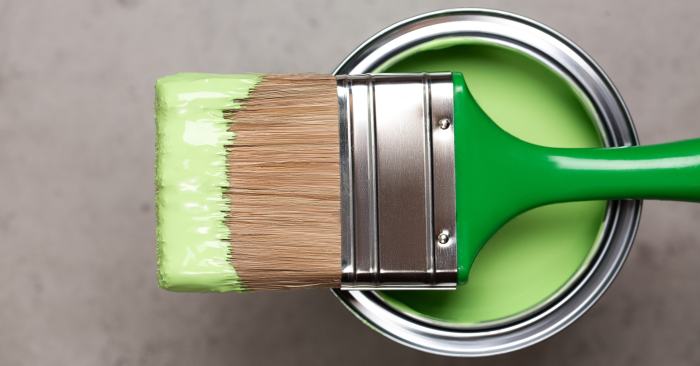
Embark on a journey towards a healthier home with eco-friendly paints. Learn about the importance of choosing sustainable options and how they can benefit both your health and the environment.
Explore different types of eco-friendly paints, considerations to keep in mind while selecting them, application techniques, and their impact on health and the environment. Dive into the world of eco-friendly painting and discover how it can transform your living space.
Introduction to Eco-Friendly Paints
Choosing eco-friendly paints is essential for creating a healthier home environment. Traditional paints contain harmful chemicals that can have adverse effects on indoor air quality and overall well-being.
Harmful Chemicals in Traditional Paints
Traditional paints often contain volatile organic compounds (VOCs) such as benzene, formaldehyde, and toluene. These chemicals can release toxic fumes into the air, contributing to indoor air pollution and posing health risks.
Benefits of Eco-Friendly Paints for Indoor Air Quality
- Eco-friendly paints are low in VOCs, reducing harmful emissions and improving indoor air quality.
- They are made from natural and non-toxic ingredients, making them safer for both the environment and human health.
- Choosing eco-friendly paints can help prevent respiratory issues, headaches, and other health problems associated with exposure to toxic chemicals in traditional paints.
Types of Eco-Friendly Paints
When it comes to choosing eco-friendly paints for your home, there are several options available in the market that are better for both your health and the environment. Let’s explore the different types of eco-friendly paints and their benefits.
Plant-Based Paints vs. Zero VOC Paints
Plant-based paints are made from natural ingredients such as plant oils, resins, and dyes, making them a sustainable and non-toxic option. These paints are biodegradable and emit fewer harmful chemicals compared to traditional paints. On the other hand, zero VOC (Volatile Organic Compounds) paints are manufactured with minimal or zero volatile organic compounds, which are harmful chemicals that can off-gas into the air.
While plant-based paints are completely natural, zero VOC paints may still contain synthetic ingredients.
Natural vs. Low-VOC Paints
Natural paints are made from ingredients like clay, lime, chalk, and natural pigments, making them a safe and environmentally friendly choice. These paints are free from harmful chemicals and provide excellent coverage. On the other hand, low-VOC paints contain reduced levels of volatile organic compounds compared to traditional paints, making them a healthier option for your home. While low-VOC paints are not entirely natural, they are still a better choice for indoor air quality.
Considerations When Choosing Eco-Friendly Paints
When selecting eco-friendly paints for your home, there are several important factors to consider to ensure you make the right choice for both the environment and your health. on the importance of considering factors such as durability and coverage, as well as how to read labels to verify eco-friendliness and tips on choosing the right paint for specific surfaces.
Durability and Coverage
- Look for eco-friendly paints that offer good durability to ensure they last longer and require fewer touch-ups over time.
- Consider the coverage of the paint to determine how many coats are needed for a satisfactory finish, as this can impact the overall environmental impact of the product.
Reading Labels
- Check for certifications from reputable organizations like Green Seal or EcoLogo to ensure the paint meets eco-friendly standards.
- Look for labels indicating low or zero VOC content, as this can help reduce indoor air pollution and improve air quality in your home.
- Avoid paints with harmful chemicals like formaldehyde, ammonia, or benzene, which can have negative health effects.
Choosing the Right Paint for Specific Surfaces
- Consider the type of surface you are painting, whether it’s interior walls, exterior siding, or furniture, and choose a paint that is specifically designed for that purpose.
- Opt for eco-friendly primers and sealers to ensure a smooth and long-lasting finish while maintaining environmental friendliness.
- Consult with a professional or the paint manufacturer for recommendations on the best eco-friendly paint options for your specific project.
Application and Techniques
When it comes to applying eco-friendly paints, there are a few best practices to keep in mind to ensure optimal results and minimize environmental impact. Proper surface preparation, application techniques, and cleanup are key components to consider.
Surface Preparation
- Begin by cleaning the surface thoroughly to remove any dirt, grease, or old paint.
- Repair any cracks or holes in the wall and sand down rough surfaces to create a smooth base for painting.
- Use eco-friendly primers to improve adhesion and durability of the paint.
Application Techniques
- Stir the paint thoroughly before application to ensure consistency.
- Apply the paint using smooth, even strokes to avoid streaks or uneven coverage.
- Allow sufficient drying time between coats as recommended by the manufacturer.
- Consider using brushes or rollers made from natural materials for a more eco-friendly application.
Cleanup
- After painting, clean brushes, rollers, and any spills with warm, soapy water instead of harsh chemicals.
- Dispose of any leftover paint or containers according to local recycling guidelines.
- Avoid pouring paint down the drain or into the soil to prevent environmental contamination.
Impact on Health and Environment

Using eco-friendly paints can have a significant positive impact on both the health of occupants and the environment. These paints are formulated without harmful chemicals, making them a safer choice for indoor spaces.
Health Benefits of Eco-Friendly Paints
- Eco-friendly paints do not contain volatile organic compounds (VOCs) which are known to cause respiratory issues, headaches, and dizziness.
- They are also free from toxic chemicals such as formaldehyde and heavy metals, reducing the risk of allergies and other health problems.
- By choosing eco-friendly paints, you create a healthier indoor environment for you and your family, especially for those with respiratory conditions or sensitivities.
Environmental Impact of Eco-Friendly Paints
- Traditional paints release VOCs and other harmful substances into the air, contributing to air pollution and indoor air quality issues.
- In contrast, eco-friendly paints are made from natural and renewable materials, reducing the carbon footprint and environmental impact of painting projects.
- Choosing eco-friendly paints supports sustainability efforts by promoting the use of non-toxic, biodegradable, and low-emission products.
Painting in Performing Arts
In the world of performing arts, stage design and set construction play a crucial role in bringing productions to life. Utilizing eco-friendly paints not only enhances the visual appeal of the stage but also contributes to a healthier environment for both performers and audience members.
Utilization of Eco-Friendly Paints in Stage Design and Set Construction
When it comes to creating captivating stage designs and sets, eco-friendly paints offer a sustainable and non-toxic alternative to traditional paints. These paints are used to bring vibrant colors and textures to the stage while minimizing the impact on the environment and the health of those involved in the production.
Importance of Using Non-Toxic Paints in Theaters and Performance Spaces
Non-toxic paints are essential in theaters and performance spaces to ensure the well-being of actors, crew members, and audience members. By choosing eco-friendly paints, the risk of exposure to harmful chemicals is significantly reduced, creating a safer and healthier environment for everyone involved in the production.
Examples of Eco-Friendly Painting Techniques Used in Performing Arts
- Water-Based Paints: Water-based paints are a popular choice in performing arts due to their low VOC content and easy cleanup. These paints are used for various applications, including creating backdrops, props, and set pieces.
- Recycled Paints: Recycled paints are made from reclaimed paint materials, offering a sustainable option for stage painting. These paints can be used to add texture and depth to set designs while reducing waste.
- Natural Pigments: Natural pigments derived from plant-based sources are used to create eco-friendly paints that are both vibrant and environmentally friendly. These pigments are often used for specialty painting techniques and artistic effects on stage sets.
Philosophy of Eco-Friendly Painting
Eco-friendly painting goes beyond just choosing healthier options for your home; it reflects a deeper commitment to ethical and sustainable living practices. By opting for paints that are environmentally friendly, you are actively contributing to the well-being of the planet and future generations. This philosophy is rooted in the belief that every individual has a responsibility to minimize their impact on the environment and make conscious choices that benefit both nature and society.
Alignment with Principles of Sustainability
Choosing eco-friendly paints aligns with the core principles of sustainability, which emphasize the importance of meeting the needs of the present without compromising the ability of future generations to meet their own needs. By using paints that are non-toxic, low in VOCs, and made from natural or recycled materials, you are supporting a circular economy and reducing the overall carbon footprint of your home.
Connection between Artistry and Environmental Responsibility
There is a profound connection between artistry and environmental responsibility when it comes to eco-friendly painting. Artists and painters have the unique ability to inspire change and raise awareness about pressing environmental issues through their work. By incorporating eco-friendly practices into their craft, they not only create beautiful and sustainable pieces but also serve as advocates for a more conscious and environmentally friendly approach to art.
Photography and Eco-Friendly Paints
When it comes to photography, the choice of backdrop can significantly impact the overall aesthetics of an image. Eco-friendly paints not only contribute to a healthier environment but also offer unique opportunities for enhancing the visual appeal of photographs.
Enhancing Aesthetics with Eco-Friendly Paints
Eco-friendly paints come in a variety of colors and finishes, allowing photographers to create custom backdrops that suit their artistic vision. These paints are often free from harmful chemicals, making them safe to use in close proximity to subjects, such as newborn babies or pets. By incorporating eco-friendly paints into their photography setups, professionals can achieve vibrant, eye-catching backgrounds that elevate the quality of their work.
Creating Sustainable Backdrops
Photographers committed to sustainability can opt for eco-friendly paints to create reusable and environmentally conscious backdrops. These paints are typically low in volatile organic compounds (VOCs), reducing the environmental impact of their production and disposal. By using eco-friendly paints to craft durable and versatile backdrops, photographers can minimize waste and contribute to a greener industry.
Examples of Eco-Friendly Paint Use in Photography
- Renowned photographer Jane Doe incorporates natural pigments and eco-friendly paints to create stunning, ethereal backgrounds for her portrait sessions.
- In a recent photo series, artist John Smith utilized non-toxic, water-based paints to achieve bold and vivid textures in his still life compositions.
- Photographer Sarah Lee promotes eco-conscious practices by repurposing old canvases with eco-friendly paint overlays, adding depth and character to her landscape photographs.
Short Fiction Inspired by Eco-Friendly Painting
In a quaint town nestled in the lush countryside, there lived a young artist named Maya who had a deep passion for painting. However, Maya was always conscious of her impact on the environment and her health, which led her to explore the world of eco-friendly paints.As Maya began using eco-friendly paints in her artwork, she noticed a significant shift not only in the vibrancy and texture of her paintings but also in her own well-being.
The absence of toxic fumes and chemicals in the eco-friendly paints made her feel more energized and inspired, allowing her creativity to flow freely.
Maya’s Transformation
- Maya’s paintings started to depict scenes of nature and sustainability, reflecting her newfound connection to eco-friendly practices.
- Her artwork gained recognition in the local art community for its unique blend of creativity and environmental consciousness.
- Maya’s health improved as she no longer had to worry about the harmful effects of traditional paints on her respiratory system.
- She began teaching workshops on eco-friendly painting techniques, spreading awareness about the benefits of sustainable art practices.
Visual Graphic Arts and Eco-Friendly Paints

In the world of visual graphic arts, eco-friendly paints have become increasingly popular due to their non-toxic nature and sustainability. Artists and designers are now opting for these paints to create beautiful and impactful works while also being mindful of the environment.
Role of Color Psychology
Color psychology plays a crucial role in choosing eco-friendly paints for artistic projects. Different colors evoke various emotions and can significantly impact the overall message of a piece. By using eco-friendly paints, artists can bring out the desired emotions in viewers while also contributing positively to the environment.
- Green: Symbolizes growth, harmony, and nature. Perfect for eco-friendly themes or designs promoting sustainability.
- Blue: Represents tranquility, calmness, and stability. Ideal for projects aiming to convey a sense of peace and serenity.
- Yellow: Signifies happiness, energy, and optimism. Great for adding a vibrant and cheerful touch to artworks.
- Neutral Tones: Earthy tones like beige, brown, and gray can create a sense of balance and timelessness in a composition.
Examples of Eco-Friendly Paint Palettes
When creating graphic design compositions, artists can explore a range of eco-friendly paint palettes to bring their visions to life sustainably. Some examples include:
| Palette 1: Forest Green, Sky Blue, Sunflower Yellow |
| Palette 2: Ocean Blue, Sand Beige, Coral Pink |
| Palette 3: Slate Gray, Olive Green, Lavender |
In conclusion, opting for eco-friendly paints not only enhances the aesthetics of your home but also promotes a sustainable lifestyle. By making conscious choices in your painting projects, you contribute to a healthier living environment for yourself and future generations.
Questions and Answers
Are eco-friendly paints as durable as traditional paints?
Eco-friendly paints can be just as durable as traditional paints, especially if you choose high-quality options and follow proper application techniques.
Do eco-friendly paints come in a variety of colors?
Yes, eco-friendly paints are available in a wide range of colors to suit your preferences and design needs.
Can eco-friendly paints be used on all surfaces?
Most eco-friendly paints are versatile and can be used on various surfaces like walls, ceilings, and trim. However, it’s essential to check the manufacturer’s recommendations for specific applications.







